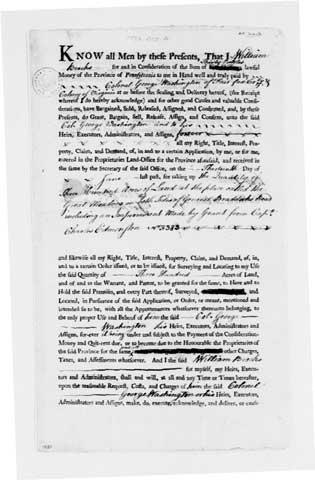Throughout history, military leaders have inevitably been linked to the scenes of their battles. General Douglas MacArthur is remembered for his "I shall return" pronouncement, but one famous American military figure went even further. He returned as a civilian and purchased a battlefield where he had fought—and lost—an engagement sixteen years earlier. A century and a half later, it became a National Battlefield.
The battle at Fort Necessity was fought in what's now called Pennsylvania in the summer of 1754. It's considered the opening action of the French and Indian War, a seven year struggle between Great Britain and France for control of North America. Although Colonial troops commanded by 22-year-old Colonel George Washington were defeated in this engagement, Great Britain's eventual success in this war helped pave the way for the American Revolution. This battle, at a place known locally as the Great Meadows, was the only time Washington surrendered to enemy forces.
In 1770 Washington was back in civilian life, and he returned to western Pennsylvania and purchased the site where he experienced his earlier defeat. The property is now preserved as part of Fort Necessity National Battlefield, and the bill of sale confirming Washington's ownership of the tract was recently donated to the park. A press release announcing the gift explains what seems like an unlikely transaction for the former military leader:
Washington saw the economic benefits of owning the Great Meadows because of its proximity to Braddock’s Road. In deciding to purchase the battlefield, Washington himself may have unknowingly preserved the site of the opening battle of the French and Indian War. With his purchase, he kept it from development until his death in 1799. We can only speculate if the purchase held sentimental value to Washington.
Most of us are intrigued by documents connected with famous historical figures, and a facsimile of the bill of sale to Washington is now on permanent display in the park's visitor center. The original is stored in a suitable location to help promote its preservation, and will be available for viewing on special occasions.
Washington's conclusion that the 234-acre tract would be a good investment proved correct. Although the area was not developed prior to his death, in 1806 Congress authorized the National Road, the first highway built entirely with federal funds. In 1828 a stagecoach stop for travelers, Mount Washington Tavern, was built on the site, and operated until 1855.
Mount Washington Tavern is now a park museum focusing on life along the National Road. Tours are available in the spring, summer and fall when staffing permits. Fort Necessity contains the reconstructed Fort Necessity, the Fort Necessity/National Road Interpretive and Education Center, the historic Mount Washington Tavern, a picnic area, and hiking trails. In winter cross-country skiing is available on the trails, although they are not mechanically tracked or groomed.
The park is located in southwestern Pennsylvania and is open from 9:00 a.m. to 5:00 p.m. daily, except on Thanksgiving Day, December 25, and January 1. Maps and directions are available on the park's website.




Add comment